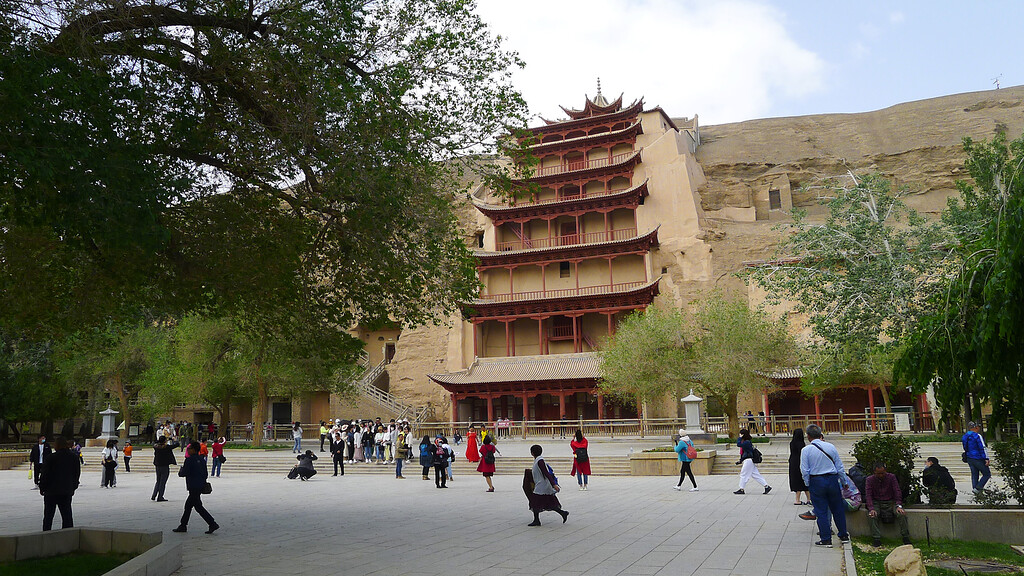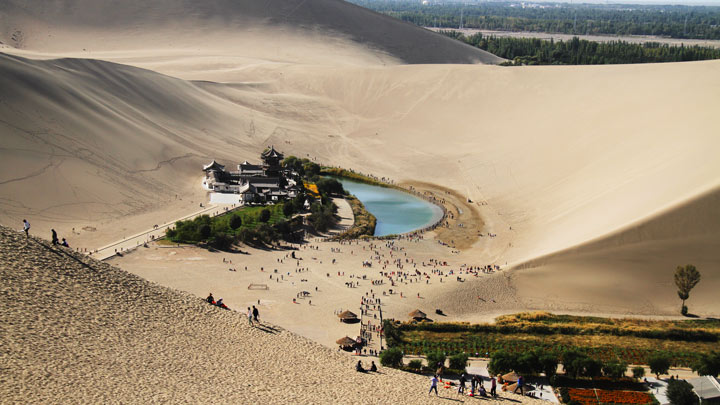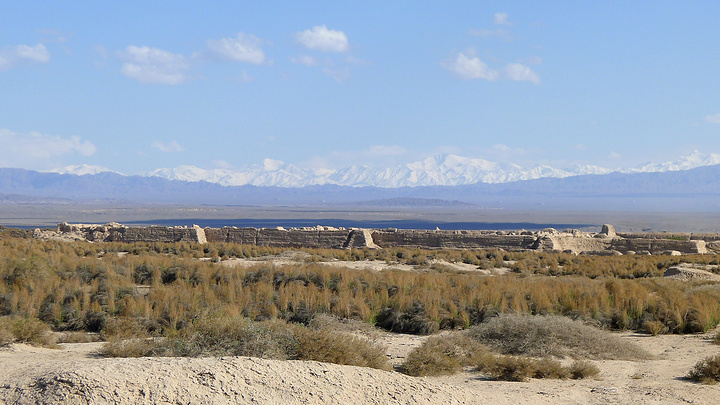
Dunhuang, Mogao Grottoes, and No. 29 Glacier (5 days)
See the highlights in and around Dunhuang—the Mogao Grottoes, Crescent Lake, Yulin Grottoes, Suoyang Ruined City—plus a hike at No. 29 Glacier, and more!
Booking info
August 16–20, 2023
| Day One main activities | Meet up in Dunhuang, evening visit to Crescent Lake and Mingsha Sand Dunes. |
|---|---|
| Day Two main activities | Morning tour of the Mogao Grottoes, afternoon visit to Danghe to see ‘modern’ grottoes and to look for fossils in the stones or the riverbed. |
| Day Three main activities | Big hike to the snowline at the No. 29 Glacier, short walkabout in a nearby town on the way back to Dunhuang. |
| Day Four main activities | Tour of Yulin Grottoes in the morning, visit Suoyang Ruined City in the afternoon. |
| Day Five main activities | Morning visit to Dunhuang Museum or free time for shopping, transfer to the airport after lunch. |
Dunhuang, Gansu Province
Dunhuang was a key stop on the northern Silk Road, allowing travelers to stock up on food and water before heading on through the desert. It’s said that a fort was built in Dunhuang around 100 B.C., and the area holds plenty of historical interest – in particular, the Mogao Grottoes, the Yulin Grottoes, and Crescent Lake. As a contrast to the Silk Road-era history of the area, we’ll add in a hike up to the lower part of Glacier No. 29.
Highlights
Mogao Grottoes

A UNESCO site since 1987, the Mogao Grottoes were dug out by Buddhist monks, starting around 366 AD. Initially, the caves were used as a place to meditate, but, over time, they began to fill up with scriptures and painted murals. Four-hundred and ninety-two caves still remain, containing statues and murals. We’ll visit around 10 of the caves to have a look at the frescoes and statues. The area is a little touristy, but well worth a look. Photography is forbidden inside the caves, but you can get a good look by bringing a torch.
The Mogao Grottoes are one of the main highlights of the trip—consider the amount of work required in construction, and then the fact that they were preserved in mostly pristine condition by being buried by blowing sand, and forgotten about for nearly 400 years.
Crescent Lake, Mingsha Sand Dunes

Crescent Lake is a crescent-shaped lake of clear water that has somehow managed to avoid being filled in by the shifting sands of the desert. A temple is located next to it, as well as the Mingsha Sand Dunes. The dunes are known as the Echoing Sand Dunes because of the strange sounds made by wind – and feet! – over the sand. The dunes are around 250m in height, from top to bottom. After climbing up, it’s super-fun to run down!
Yulin Grottoes

The Yulin Caves are similar to the Mogao Grottoes, but smaller. They’re located in a canyon near Guazhou, about a two-hour drive from Dunhuang.
We’ll visit the caves for a walkabout that includes two of the ‘special’ caves that aren’t part of the regular tourist visit.
Suoyangcheng Ruined City

The Suoyangcheng Ruined City dates back to the early Han Dynasty. The city emptied out after a Mongolian attack in the sixteenth century. After that, the slow change in course of a nearby river meant it wasn’t ever seriously resettled – no easy water supply – and with that, the city became abandoned.
We’ll take a quick tour around the remains of the city—rammed earth remnants of the city walls that are slowly being covered by sand, and the remains of the Ta’er Temple.
Hiking near the No. 29 Glacier
We’ll drive out to the mountains southeast of Dunhuang for a day hike that will take us up to the slowly-disappearing No. 29 Glacier.
The glacier is part of a scenic area, and a typical visit has a short hike assisted by park area vehicles. We’ll aim to go a bit further, starting off in the foothills of the mountains and aiming to hike up to the snow line.
Many of the Silk Road-era sights you’ll see on this trip were sited by rivers and streams fed by snowmelt from the nearby Qilian Mountains’ snowpack and glaciers, and some of those Silk Road sites were also abandoned when those rivers and streams dried up or changed course.